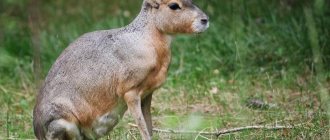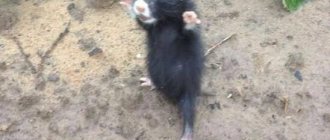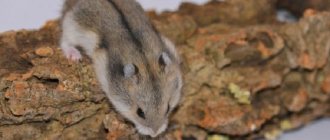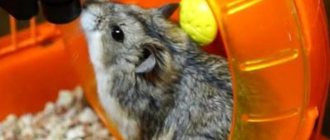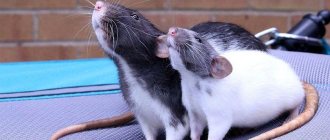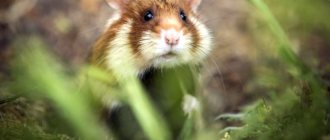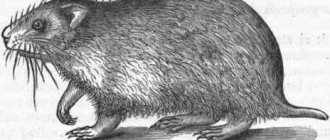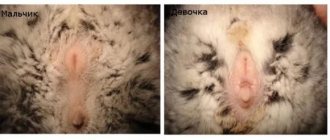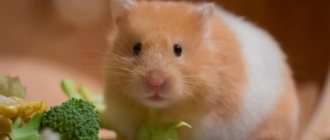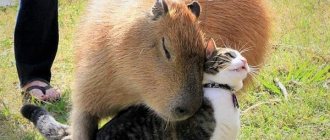Description of the rodent
Red hamster eats a leaf
– Advertisement –
Hamsters are small rodents with a dense build, short legs, small ears and short tails. The body length ranges from 5 to 34 cm, the tail is from 0.7 to 10 cm in length. Females can exceed males in size. The fur is thick, the back is colored from ash or brownish-gray to dark brown-ochre. The abdomen is found in black, white or gray. There is a pronounced black stripe on the back. Hamsters also differ from other types of rodents in having well-developed cheek pouches.
How to determine if you are overweight?
To find out if your hamster is obese, you need to do the following:
- Take the animal in your hands and gently lay it on its back.
- Feel the ribs from the abdominal side.
If during the examination you notice that the ribs protrude and can be felt too clearly, this indicates that the animal is underweight and needs to be fed better. The inability to feel the ribs indicates that the pet has problems with excess weight. If each of the animal's ribs can be felt individually, but they do not protrude, we can say with confidence that the pet's weight is normal.
Hamster nutritional features
A hamster eats corn at a small table.
Hamsters are omnivorous rodents, but their diet is dominated by plant foods. In addition, hamsters feed on insects and their larvae, small vertebrates (mice, reptiles and amphibians). In the autumn, they switch to seeds and tubers, and also store them in quantities from 0.5 to 11-16 kg. Sometimes hamsters' storerooms with grains and potatoes reach 90 kg. Hamsters also bring grain, peas, rice, millet, buckwheat, lupine, corn, lentils, potatoes to the pantries, putting different varieties of seeds separately. The hamster feeds on these reserves in the winter, temporarily waking up from hibernation, and in the spring until fresh food becomes available.
The hamster carries food in its cheek pouches, which contain about 46 g of wheat. Can carry food for about 1 km.
The most depressed hamsters
Each animal has its own characteristics in character. Without knowing them, it is difficult for the owner to understand what his pet wants and what his mood is. The hamster is no exception. Just like people, they can get depressed. It often occurs in pets in winter.
Hamsters feel anxious and restless. American scientists decided to use this property of rodents in order to understand the cause of depression in people and find ways to eliminate it. The study involved 53 female and 48 male dwarf hamsters under the supervision of a professor at Ohio Medical University.
The animals were limited in their access to daylight to simulate winter days. Scientists also conducted special tests for anxiety. The researchers placed the rodents in a large cardboard box and observed how long the hamsters stood near the walls for 1 hour. This is exactly how restless hamsters behave.
In addition, the animals were given a sweet drink for several days. If a rodent did not drink it, it was considered “depressed.” As a result of such an experiment, it was found that hamsters are susceptible to seasonal depression.
The most depressed hamster is considered to be a rodent named Chmurka. The facial expressions and behavior of this animal speaks for itself.
Hamster spread
— Advertising —
Hamster distribution map
Hamsters are widespread in Central and Eastern Europe, Asia Minor, Syria, Iran, Siberia, Mongolia, northern China and Korea.
The largest populations live in the forest-steppe and steppe. In the south it prefers damp areas, such as river valleys. In the mountains it is found at altitudes up to 3600 m above sea level, up to mountain meadows and forests. It also develops cultivated areas, such as rice fields, forest belts, parks, orchards, vegetable gardens, and residential buildings. Prefers dense soils, rare on sandy soils.
Conservation status
Until 1960, the soft-haired animal was the object of the fur trade in Czechoslovakia, Germany and the USSR. A sharp decline in numbers forced the cessation of fur harvesting in the middle of the 20th century. Western European countries have approved national programs to ensure the conservation of this species.
These include Belgium, the Netherlands, Germany, Poland, France, Belarus and Ukraine. It is also protected in five constituent entities of the Russian Federation.
The number of animals is unchanged in Siberia and Kazakhstan, and the number of animals in the Krasnodar Territory and Azov District of the Rostov Region causes significant damage to agriculture. Although the total number of the species continues to decrease.
Did you know? Smart hamsters can remember their name and perform some tricks.
Common types of hamster
Common hamster (Cricetus cricetus)
A common hamster emerges from its burrow.
The body length of adult males is 27-34 cm, the tail is 3-8 cm long, weight is about 700 g. The tail becomes thinner towards the end, covered with short, stiff hairs. The ears are short and dark. The fur is thick and soft. The color is bright and contrasting. The back is reddish-brown, the belly is black. On the sides there are two large light spots separated by black fur. There are also light spots on the sides of the head and behind the ears. There are specimens that are black or black with white spots on the legs and neck. In total, more than 10 subspecies of the common hamster have been described. The color becomes lighter from north to south, body size increases from west to east and from north to south.
The species lives in the meadow and forest-steppe of Eurasia from Belgium to Altai and Northern Xinjiang.
Syrian hamster, or Central Asian hamster (Mesocricetus auratus)
Syrian hamster in its burrow
Body length is about 13 cm, tail up to 1.5 cm. Weight ranges from 100 to 125 g. The fur is soft, thick, golden.
It is found in nature near the Syrian city of Aleppo and in eastern Turkey.
Brandt's hamster or Transcaucasian hamster (Mesocricetus brandti)
The Caucasian hamster hides in the grass.
Body length is 15-18 cm, tail length is 2-3 cm. Weight is up to 300 g. Ears are small. The back is earthy brown. The belly is brownish-gray, there is a black spot on the chest. The sides of the head are yellowish-red, there are long black spots under the ears, and the chin is white. Paws are white. The fur is soft and thick on the tail.
The species' habitat includes Turkey, Israel, Lebanon, and the eastern Ciscaucasia. Inhabits steppes on mountain slopes, mountain meadows and cultivated areas.
Radde's hamster or Cis-Caucasian hamster (Mesocricetus raddei)
Radde's hamster in the grass - photo
Body length up to 28 cm, tail length about 1.5 cm. The back is brownish. The belly is black or dark gray. There are light spots on the cheeks and behind the ears.
Distributed in Georgia and Russia, in the North Caucasus, in the Stavropol Territory and in the Ciscaucasia, in the steppes and forest belts.
Newton's hamster (Mesocricetus newtoni)
Newton's hamster in the steppe
Body length 14-17 cm, tail length up to 2 cm, weight 80-150 g. The back is gray-brown, with a black stripe running down the center of the back. The neck and chest are black-brown, the belly is yellowish-gray.
Found along the Danube, in Bulgaria and Romania.
Djungarian hamster (Phodopus sungorus)
Djungarian hamster
Body length up to 10 cm, weight 35-65 g. Gray back decorated with a dark stripe, short tail. Fur with white spots.
Inhabits dry steppes and semi-deserts in the south of Western Siberia, Dzungarian Alatau, and Khakassia.
Campbell's hamster (Phodopus campbelli)
Campbell's hamster - photo
Body length 7-10 cm, short tail, up to 1.5 cm long, weight about 25 g. The head is round, the muzzle is short. The fur is dark gray with a brown tint, there is a dark stripe on the back, and the belly is gray.
The species is distributed in Mongolia, northern China, Russia and Kazakhstan.
Roborovski's hamster (Phodopus roborovskii)
Roborovsky hamster photo at home
A small species with a body length of 4-5 cm, weighing about 30 g. The head and back are sandy-golden, the abdomen is white. Light spots are visible above the eyes.
Found in Mongolia, China and Russia.
Short-tailed hamster (Cricetulus alticola)
Short-tailed hamster in the grass
Body length is 8-10 cm, weight ranges from 22 to 48 g. The fur is gray-yellow-brown without spots.
It lives in the north of South Asia and China, at altitudes of about 4000 m above sea level, in coniferous and birch forests, and in the steppes.
Barabinsky hamster (Cricetulus barabensis)
Barabinsky hamster - photo
Outwardly similar to an ordinary hamster. Inhabits forest-steppe and semi-deserts in the south of Western Siberia, Tuva, Transbaikalia, Mongolia, northeast China, Primorye (Russia) and Korea.
Gray hamster (Cricetulus migratorius)
Gray hamster in the steppe - photo
Body length 10-13 cm, tail 2-3.5 cm long. The coat is gray on top, the abdomen and tail are light. The eyes are large. The ears are small.
The species' habitat includes Eastern Europe, Russia, Asia to western China.
Sokolov's hamster (Cricetulus sokolovi)
Sokolov's hamster on a stone
Body length from 7 to 11 cm, tail length up to 3 cm. The back is gray with a dark stripe. The abdomen is light gray. There are dark brown spots in the center of the ears.
Found in sandy areas of Mongolia and China.
Mongolian hamster (Allocricetulus curtatus)
Mongolian hamster in the Berlin Zoo
A small species with a body length of 10-15 cm, a tail 1.5-2 cm long. The color is light, the tummy, tail and paws are white. The tail is fluffy.
It lives in the Zaisan depression in the south of Tuva, China and Mongolia.
Eversman's hamster (Allocricetulus eversmanni)
Eversman's hamster - photo
Body length 13-16 cm, tail 2-3 cm long. Legs short. The ears are small. The tail is wide, flattened, densely pubescent. The fur is short, soft, velvety. The back is blackish-brown or fawn-red or ash-sandy. The belly is white with a sharp border on the sides. There is a brown spot on the throat and chest. The paws and tail are white below.
Lives in the Lower and Middle Trans-Volga region, in the south of the Trans-Urals, in Kazakhstan.
Kansky hamster (Cansumys canus)
The Kansky hamster lies on its stomach.
Body length is from 10 to 17 cm, tail is 7-10 cm. Weight is from 60 to 120 g. The fur is thick, the back is gray with white spots on the cheeks and near the ears. The belly and tip of the tail are white.
The species is distributed in central China.
Rat-like hamster (Tscherskia triton)
Tscherskia triton in a cage
Body length from 14 to 25 cm, tail 7-10 cm long. Weight from 92 to 241 g. The back is light gray-brown, the tail is dark brown with a white tip, the paws are white.
The habitat includes northeast China, the south of Primorsky Krai, and Korea.
Habitat
The common hamster lives mainly in the steppe and forest-steppe zones of Eurasia. Its distribution area is quite wide. Animals of this species are found in the northwestern part of China, in the east and south of Siberia, in Kazakhstan and the northern part of Mongolia.
The large Radde hamster prefers to settle on already developed lands in the steppes, which are rich in perennial grasses. Representatives of this species are found in the Caucasus, Stavropol region, Ciscaucasia, and also in Georgia.
Reference. The number of common hamsters has decreased significantly over the past 20 years, so programs have been developed in different European countries to protect these animals.
Hamster behavior
Hamster on a walk
Hamsters are terrestrial animals; some species can swim by taking air into their cheek pouches. They usually live alone, in burrows. Outside the breeding season, hamsters behave aggressively towards their relatives and often start fights. In winter, they fall into a prolonged torpor, which is still not real hibernation.
Hamsters are characterized by a twilight lifestyle. During the day they remain in their burrows, which reach 8 m in length and 1.5 m in depth. May occupy gopher burrows. In a permanent burrow there are from 2-5, sometimes up to 10 exits, a nesting chamber and storerooms.
Lifestyle
It lives underground, making a deep (up to two meters) and long (up to 8 meters) burrow. Such a dwelling has its own storage room, several nests for rest, up to five, less often ten entrances and exits. In rare cases, a gopher or other burrowing animal may take over the house.
The floor in the hole is lined with straw. Each “door” has its own function:
- Usually a gentle descent into a hole is the way out.
- The more vertical hole is the entrance, through which the animal returns home; it especially likes to use it in times of danger.
- The third tunnel leads to the “storage room”.
During the winter, the hamster plugs all the holes with earth.
The animal is very clean, its house is a standard of cleanliness, it never “soils” in the living area, and especially in the storage area, and uses special latrines for this.
The common hamster is a loner and forms temporary pairs only during the mating season.
In everyday life he is aggressive and pugnacious. If there is a mortal threat, it can even rush at a person.
The animal has a terrifying appearance: it stands on its hind legs, snaps its teeth and moves to attack.
Natural predators for the rodent are foxes, ferrets, stoats, eagles, owls, and eagle owls.
In winter, the animal hibernates, occasionally wakes up to eat and goes back to sleep. During mild and warm winters they often wake up and even come to the surface.
Hamster breeding
A female hamster with her offspring
Hamsters are known for their fertility, producing 2-4 litters per year. The duration of pregnancy is from 15 to 22 days, in one litter there are from 1 to 18 babies, they become sexually mature already at the 6-8th week of life. Under natural conditions, hamsters live from 1 to 3 years, at home about 3 years.
Record holders for size
The largest hamster in the world is the capybara Caplin Rose. The owner of the giant pet is Melanie Typaldos. The weight of the animal is 64 kg, and the body length is 1.4 meters. Melanie named her pet after the huge rodent from the fairy tale “The Princess Bride.” Typaldos claims that the animal is very friendly and plays with children and even dogs.
A hamster's favorite pastime is to swim in the river, and then eat ice cream and fall asleep. Melanie even writes a blog about her pet, which is popular.
Natural enemies of the hamster
The main enemy of the hamster is the heron.
Hamsters become victims of such predators as the red and black kite, buzzard, lesser spotted eagle, fox, ermine and badger. Kestrels, gray herons, carrion crows, and rooks prey on the young.
Notes
- Sokolov V. E.
Five-language dictionary of animal names. Mammals. Latin, Russian, English, German, French. / under the general editorship of academician. V. E. Sokolova. - M.: Rus. lang., 1984. - P. 156. - 10,000 copies. - [genomics.senescence.info/species/entry.php?species=Cricetus_cricetus Black-bellied hamster (Cricetus cricetus) longevity, aging, and life history]. Retrieved January 3, 2013. [www.webcitation.org/6Do9jpKM0 Archived from the original on January 20, 2013].
Pet hamsters
Domestic hamster in a cage
Syrian, Djungarian, Campbell and Roborovian hamsters are kept at home. Syrian hamsters come in a wide variety of colors, patterns, and coat types. Long-haired Syrian males are sometimes mistakenly called "Angora".
When choosing a hamster, take into account that Roborovsky hamsters can live in flocks, while other species are solitary, and when they are kept together, fights arise, which often lead to the death of the weaker of the hamsters. When hamsters of different sexes are kept together, the female gives birth very often, which harms her health and shortens her life. A pregnant female is capable of killing or injuring a male while protecting her cubs.
The dimensions of the cage for hamsters must be at least 50 cm by 30 cm. A wheel with a running surface (14-18 cm in diameter) must be installed in the cage. Eating at home is no different from eating in nature. The diet is based on cereals and green plants.
For mating, a pair is selected from a male aged 4 months and a female aged from 9 months. They are brought together on neutral territory or in a male’s cage during the female’s estrus period, which occurs for several hours every 4 days. Pregnancy lasts from 17 to 20 days. At the age of 4 weeks, the young animals are separated from the female, separated by gender.
Ways to fight and protect
Nowadays, both modern methods of combating and protecting against these rodents, as well as proven old ones, are used. Here are the main ones:
- Flooding holes . You need to find all the exits, barricade them and pour water into the hole until the animal crawls out of the only hole. There you can catch him. Minus: be careful that you have found all the emergency exits from the hole, otherwise the hamster will hide.
- Digging holes and catching by hand . Disadvantage: very labor-intensive and dangerous.
- Domestic animals , cats and dogs, hunt rodents. Minus: hamsters are very large, not every cat can handle it. And a dog can trample the entire garden. In addition, the hamster can bite them and infect them.
- Various traps , live traps. Cons: It can be difficult to keep track of where it can get out and where to place them.
- Spreading poisoned baits . You can use rat and mouse poison. Minus: it is not a fact that the majority of individuals will eat it, especially since the number of pests is quickly restored.
- Use of noise and ultrasonic repellers . Disadvantage: it is difficult to place them over a large area and quite expensive.
The big problem is that hamsters are very active and cunning animals, and also fearless. Catching or scaring away a hamster in the countryside is not so easy.
Dear gardeners and gardeners! You must definitely try all the ways of fighting and destroying until you achieve success!
Otherwise, you risk not only being left without a harvest on your farm, but also your own health and life, as well as your loved ones!
Interesting facts about the rodent:
Hamster runs with food in his cheeks
- The word “hamster” is of Old Church Slavonic origin, in turn borrowed from ancient Iranian, where “hamaēstar” is translated as “an enemy who throws to the ground.” This probably indicated that the hamster bends the stem of the cereal towards the ground and thus gets the seeds.
- The Syrian and Newton's hamsters are included in the International Red Book.
- Hamsters cause damage to agriculture as they feed on legumes and grain crops. In addition, they are carriers of pathogens of a number of infectious diseases, which is why their keeping is prohibited in Vietnam. The maximum fine for violation is 30 million VND, which is equal to the annual income of a resident of this country. But hamsters also bring benefits. For example, the skins of certain types of hamsters are harvested. Hamsters are also used as laboratory animals and pets.
Harm to a person - a farmer
Karbysh often settle near fields, dachas, and farms. With large populations, they are capable of causing great damage to crops. Everything that a rodent finds in the field is edible for it.
It is easy to detect the presence of a rodent: you can see teeth marks on fruits and vegetables, bark has been eaten at the bottom of trees and bushes. Traces of digging are visible on plantings of potatoes, carrots and other root crops.
Hamsters reproduce exponentially. If no measures are taken, they will fill all the fields with their holes.
Hamsters bring not only harm, but also benefit, destroying beetle larvae in the fields, eating insect pests, including locusts, which cause enormous damage to farmers.
